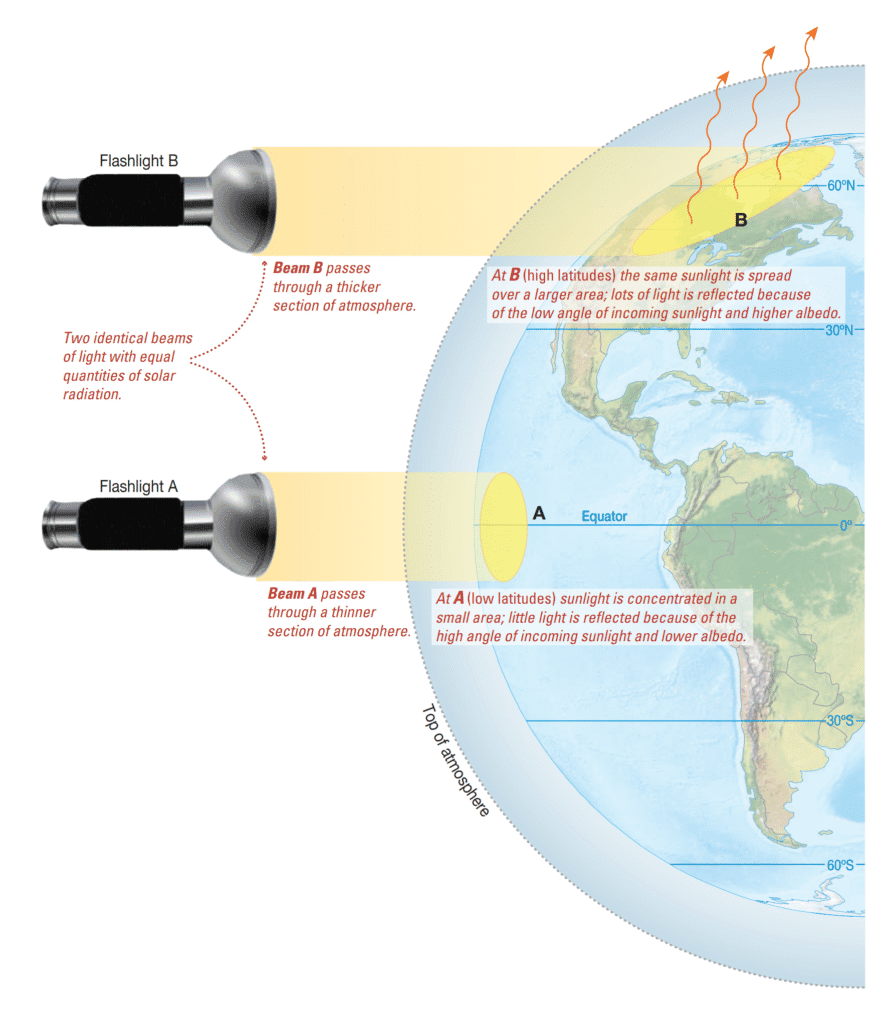How Latitude Affects the Distribution of Solar Radiation
If Earth were a flat surface oriented perpendicularly to the Sun, solar rays would be distributed uniformly across its entirety. However, due to Earth’s spherical shape, the intensity and quantity of solar radiation significantly vary with latitude. Regions situated at higher latitudes receive markedly less solar energy compared to those near the equator. Several key factors govern the differential in solar radiation between low and high latitudes:
- Solar Footprint. In equatorial regions, the Sun is frequently positioned almost directly overhead, resulting in sunlight striking the surface at a steep angle. Consequently, solar energy becomes concentrated over a relatively limited area (area A). In contrast, toward the polar regions, sunlight arrives at a shallower angle, causing the same quantity of solar radiation to be dispersed across a larger surface area (area B).
- Atmospheric Absorption. As solar radiation travels through Earth’s atmosphere, a portion of it is absorbed, thereby reducing the amount that ultimately reaches the surface. At higher latitudes, sunlight must traverse a greater thickness of the atmosphere, which leads to a greater loss of radiation compared to lower latitudes, where the atmospheric path is shorter and attenuation is minimized.

- Albedo. The albedo (from albus, meaning white) refers to the proportion of incoming solar radiation that is reflected back into space, and it varies with different Earth surface materials. For instance, thick sea ice blanketed by snow can reflect up to 90% of incoming solar energy, indicating an extremely high albedo. This characteristic contributes to a greater percentage of solar radiation being reflected in ice-dominated high-latitude regions, unlike low-latitude areas, which generally lack extensive ice cover. In contrast, other materials such as ocean water, soil, vegetation, sand, and rock exhibit significantly lower albedo values. On average, the global surface albedo is approximately 30%.
- Reflection of Incoming Sunlight. The incident angle at which solar rays strike the ocean surface determines the balance between absorbed and reflected energy. When the Sun is positioned directly overhead, only about 2% of solar radiation is reflected by a calm sea surface. However, when the solar elevation is merely 5 degrees above the horizon, as occurs frequently at high latitudes, nearly 40% of the radiation is reflected back into the atmosphere. This effect results in greater solar reflection from the ocean in polar regions than in the tropics.
Reflection and Absorption of Solar Energy Relative to the Angle of Incidence on a Flat Sea
| Elevation of the Sun Above the Horizon | Reflected Radiation (%) | Absorbed Radiation (%) |
|---|---|---|
| 90° | 2 | 98 |
| 60° | 3 | 97 |
| 30° | 6 | 94 |
| 15° | 20 | 80 |
| 5° | 40 | 60 |
Other factors also play a crucial role in determining the quantity of solar energy that arrives at Earth’s surface. One notable example is the daily variation in radiation caused by Earth’s rotation on its axis, which results in alternating periods of daylight and darkness at any given location. Additionally, the annual fluctuation in solar radiation is linked to the progression of Earth’s seasons, which further alters the distribution and intensity of incoming solar energy throughout the year.
Reference: All images and content are taken from Essentials of Oceanography by Alan P. Trujillo and Harold V. Thurman, 12th Edition.
